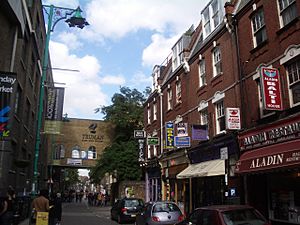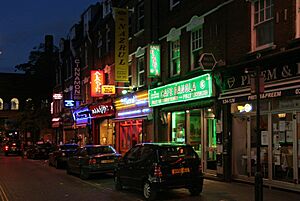Brick Lane facts for kids
Brick Lane is a famous street in the London Borough of Tower Hamlets, in the East End of London. It is part of an old area that includes places like Bethnal Green, Whitechapel, and Spitalfields.
Today, Brick Lane is known as the heart of London's British Bangladeshi community. Some people even call it Banglatown! It is very popular for its many delicious curry restaurants. Brick Lane has a very interesting and long history.
Contents
History
Why is it called Brick Lane?
Brick Lane got its name because people used to make bricks and tiles there. This started way back in the 1400s. They used special clay found in the local area.
Waves of Newcomers
Over many years, different groups of people came to live in Brick Lane. The first big group were Huguenot refugees in the 1600s. They were skilled weavers and started a connection with the clothing industry. This link lasted for over 300 years.
After the Huguenots, Irish immigrants arrived. Then came Ashkenazi Jews. In the last century, many Bangladeshis moved to the area. Because there were many new people looking for work, Brick Lane became a centre for weaving, tailoring, and the clothing industry.
Brewing and Markets
Making beer, or brewing, started in Brick Lane before 1680. Brewers used water from deep wells. A famous brewer named Joseph Truman began his business there in 1683. His family later built the large Black Eagle Brewery on Brick Lane.
The Brick Lane Market began in the 1600s. It first sold fruit and vegetables. The Sunday market, like others nearby, started because of a special rule for the Jewish community. A new Brick Lane Farmers' Market opened in 2010.
A Building with Many Stories
A special building on the corner of Brick Lane and Fournier Street shows the area's changing history. In 1742, it was built as a Huguenot chapel. By 1809, it became a chapel for Jewish people. In 1819, it became a Methodist Chapel.
Later, in 1898, it became a Synagogue for the growing Jewish community. Then, in 1976, it became the London Jamme Masjid (Great London Mosque). This was to serve the many British Bangladeshi immigrants who had moved to the area. Many of these immigrants came from the Sylhet Division region of Bangladesh. This building is very important and is protected as a Grade II* listed site.
Images for kids
-
The Brick Lane Mosque, used first as a church and then a synagogue, reflecting changing demographics.
-
The heart of Brick Lane shown running N-S through, or along the eastern edge of the Parish of Spitalfields, c.1885. Bethnal Green lies north and north-east, with Whitechapel south and south-east.
See also
 In Spanish: Brick Lane para niños
In Spanish: Brick Lane para niños













